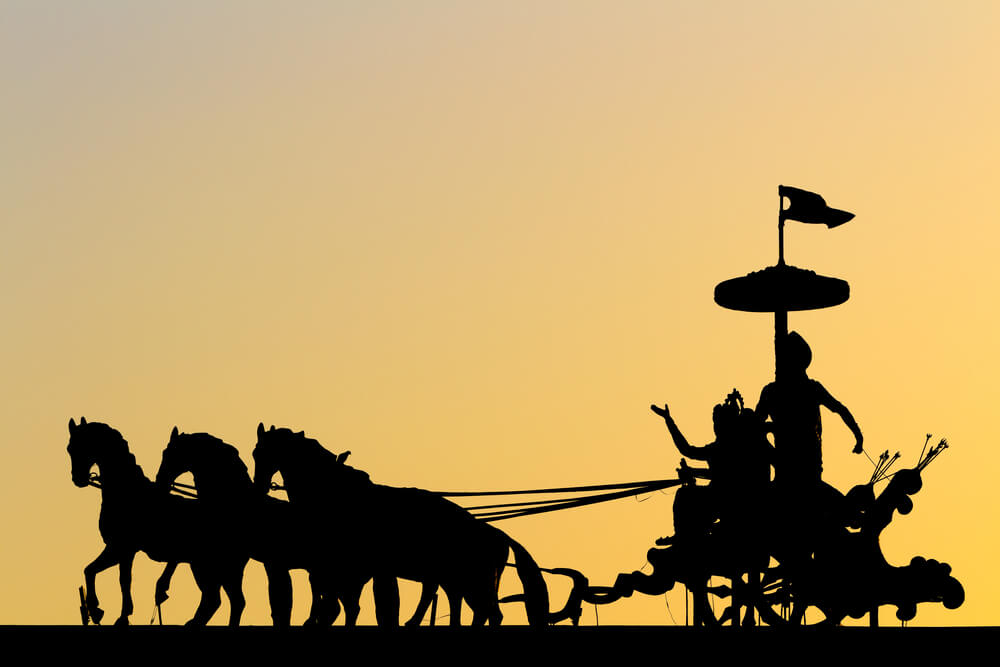One of the two main Sanskrit epics of ancient India, together with the Ramayana, is the Mahabharata. The Kurukshetra War between two groups of cousins is described, as well as the fates of the Pandava and Kaurava princes and their heirs. The Mahabharata, the world’s longest-known epic poem, has been termed “the longest poem ever written.” The sage Vyasa, who also plays a significant role in the epic, is credited with writing it. He also talks about the Guru-shishya tradition, which dates back to the Vedic era and connects all notable instructors and their disciples. The epic uses the frame tale narrative structure, which is common in both religious and secular works in India.
There are many translations of Mahabaratha available to read that are written by different authors:
-
Mahabharata: Bibek Debroy
The Critical Edition of the Mahabharata, as published by BORI, was completely translated into English by this author, Bibek Debroy, over more than six years. He makes it simple for the reader and writes with beauty and sincerity. However, a few noticeable exceptions in the critical edition might not be to everyone’s taste.
-
Jaya: Devudtt Patanaik
The author knows how to craft a lovely story, and this book is simple to read. Through its 108 chapters and numerous eye-catching images, Jaya provides a quick summary of the Mahabharata for individuals on the road. The original Mahabharata, which was penned by Sage Vyasa, was called Jaya, incidentally.
-
Yuganta: Irawati Karve
The novel was initially written in Marathi, which is thought to be a far superior translation because the English version is not a literal translation. This book contains essays on several Mahabharata characters and the story as it is told from their points of view. She presents some divisive viewpoints that are supported by evidence.
-
Palace of Illusions: Chitra Banerjee Divakaruni
This is a lovely book to read because it offers Draupadi’s perspective on the Mahabharata from the viewpoint of a woman. According to her account, Draupadi was always secretly in love with Karna and later regretted choosing to marry the Pandavas.
-
Mahabharata: C Rajgopalachari
A must-book for someone who starts young. The book, which comprises roughly 450 pages, should be purchased by everyone who wishes to understand more about Mahabharat. The language is straightforward, understandable, and quick-paced. After reading this book, you will no longer believe the numerous myths that modern-day retellings of TV serials have generated.
-
Critical edition
The Critical Edition of the Mahabharata, consisting of 13,000 pages in 19 volumes, was created during 47 years between 1919 and 1966 by researchers at the Bhandarkar Oriental Research Institute in Pune.
What is the best way to read the Mahabharata?
- Especially for devoted readers and fans of mythology, reading more than 80,000 shlokas can be a challenging task, even when they are translated into simple text. It can be read in many different languages, including Sanskrit and English. Reading it broadens the imagination, adds color to the complex fabric of people and circumstances, and stimulates fresh ideas and thoughts. You can read it for pleasure and enjoyment to marvel at the fascinating universe of stories inside stories, or you can read it philosophically to get new perspectives on the fundamental issues of life and purpose.
- The Mahabharata is just too difficult for a novice. Furthermore, while having a Great God as its focal figure, it is not an “introduction to Hinduism” because it is much more about politics and ethics than religion or devotion. If you have no prior knowledge of Hinduism, you should read a simple introduction to the religion that nonetheless provides a good understanding. You won’t be able to comprehend Hindu scriptures otherwise. The Gita, the Upanishads, and, if you’re interested, the Brahma Sutra, are some of the key Hindu books that can then be read. Try reading the Mahabharata translation by K. M. Ganguli.
- There are at least three layers to The Mahabharata that can be read more than once. Who is related to whom? and other questions are addressed in the first, most fundamental layer, which also describes the main plot. What happened most prominently? What was the order of the events? What came out of it? The extremely well-known Mahabharata by C.Rajagopalachari also provides a brief, straightforward, and complete explanation that would be easy for a beginner to understand. The second layer entails reading about politics and ethics. We can attempt to put ourselves in the shoes of the key characters and attempt to comprehend their motivations as well as apply the prevailing moral code or Dharma as they would have done. This will allow us to see how the code was either upheld or broken in each incident and what the results were. The Mahabharata’s most notable characteristics are its abundance of admirable characters and perplexing ethical dilemmas. The Bhagavad Gita, Lord Krishna’s timeless message to humankind through the Mahabharata, is the main focus of the third layer, which is spiritual. It is accurate since the spiritual layer is the top layer and the reason why the Mahabharata is not typically suggested to beginners as an “introduction to Hinduism.”
- You can start with the Bhagwad Gita which is the most-read portion of the Mahabharata. The story opens with Prince Arjuna feeling torn between his duty to his nation and people as a warrior-leader and his duty to his kin whom he faces in combat. This is perhaps the most important lesson you will learn. The entirety of the language that follows is lord Krishna giving Arjuna advice and responding to his inquiries. I also strongly advise beginning with a version without commentary. This enables you to develop your own opinions regarding the text. The Mahabharata depicts the development of Hinduism and its relationships with other religions throughout its production, in addition to its main plot and recounts of other myths.
- Please choose Amar Chitra Katha’s Mahabharat if you wish your children to understand the enthralling knowledge of epics. The vivid, realistic, and brilliant Amar Chitra Katha comics of the 1980s served as an excellent introduction to the vast and intricate world of the Mahabharata. It’s fantastic to spark interest in our rich Hindu culture and is only for kids. Mahabharat by Geeta Press is another option for devoted Hindi readers. Start with Devdutt Pattanaik if you want to read the Mahabharata in English. The interpretations by John D. Smith, C. Rajagopalachari, and others are also excellent. There are several options for readers of the English language. Amar Chitra Katha, a book for all ages that is beautifully drawn and energetic, is a great place to start. Alternately, one could plunge headfirst into Bibek Debroy’s expansive translation.
- The Mahabharata is replete with Hindu mythology, cosmological tales of the gods and goddesses, and parables intended for Hindu philosophy students. The stories that are part of Mahabharata are Bhagvadgita, Damayanti, Krishnavatara, Rama Rishyasringa, Vishnu sahasranama. After all, the Mahabharata is an explanation of dharma, which covers the right behavior for a monarch, a warrior, a person who must survive a catastrophe, and a person trying to achieve Moksha.
Read More :- How to Read Bhagwad Gita
Conclusion
Reading Mahabharata broadens the imagination, adds color to the complex fabric of people and circumstances, and stimulates fresh ideas and thoughts. The Mahabharata is experienced quite differently by children, young adults, middle-aged people, and the elderly. According to Shri Krishna, this is the tale of a flower that grows from a seed in a dark, muddy place, overcomes many obstacles to become a lovely blossom, and finally bears fruit.
FAQs
Is there an English version of Mahabharata?
Kishori Mohan Ganguly’s Mahabharat and Bibek Debroy’s Mahabharat are the popular English versions of Mahabharat.
What are the 5 main topics of the Mahabharat?
- A desire for vengeance will only fail.
- Even if you have to battle for it, stick up for what’s right.
- The enduring friendship bond.
- Don’t let greed influence you.
- Despite all obstacles, we must not give up on life.
Who translated Mahabharat into English?
Kisari Mohan Ganguli and Bibek Debroy translated Mahabharat in English.
Who wrote Mahabharat?
The Mahabharata is thought to have been written by Rishi Vyasa.
What language did Krishna speak?
Lord Krishna gave his messages in the Sanskrit language.
What is the central message of Mahabharat?
The main message of Mahabharat is the idea of sacred duty.
How old is Mahabharat written?
Most Mahabharat was written between the 3rd century BCE and the 3rd century CE.
Who first translated Mahabharata into English?
Kisari Mohan Ganguli first translated Mahabharat into English between 1883 and 1896.

